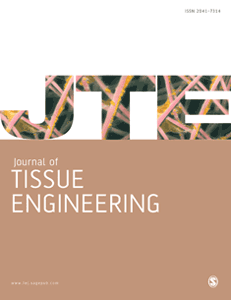基于三周期性最小表面的添加式制造生物陶瓷支架用于骨再生
IF 7
1区 工程技术
Q1 CELL & TISSUE ENGINEERING
引用次数: 0
摘要
这项研究的重点是孔隙率不同的三重周期性最小表面(TPMS)支架对新西兰白兔下颌骨缺损修复的影响。四种 TPMS 构型(孔隙率分别为 40%、50%、60% 和 70%)是通过增材制造技术用 β 磷酸三钙生物陶瓷制成的。通过扫描电子显微镜和机械测试评估了支架的特性。为了进行增殖和粘附试验,在这些支架上培养了小鼠骨髓干细胞(BMSCs)。在体内,将支架植入兔下颌骨缺损处 2 个月。组织学染色评估了成骨潜能。此外,RNA 序列分析和 RT-qPCR 显示,血管生成相关因子和 Hippo 信号通路对 BMSCs 的行为有显著影响。值得注意的是,孔隙率为 70% 的 TPMS 支架表现出最佳的抗压强度、优异的细胞增殖性和粘附性,并显著增强了骨生成和血管生成。这些发现强调了 70% 多孔性 TPMS 支架在有效促进下颌骨缺损骨再生方面的巨大潜力。本文章由计算机程序翻译,如有差异,请以英文原文为准。
Additively manufactured bioceramic scaffolds based on triply periodic minimal surfaces for bone regeneration
The study focused on the effects of a triply periodic minimal surface (TPMS) scaffolds, varying in porosity, on the repair of mandibular defects in New Zealand white rabbits. Four TPMS configurations (40%, 50%, 60%, and 70% porosity) were fabricated with β-tricalcium phosphate bioceramic via additive manufacturing. Scaffold properties were assessed through scanning electron microscopy and mechanical testing. For proliferation and adhesion assays, mouse bone marrow stem cells (BMSCs) were cultured on these scaffolds. In vivo, the scaffolds were implanted into rabbit mandibular defects for 2 months. Histological staining evaluated osteogenic potential. Moreover, RNA-sequencing analysis and RT-qPCR revealed the significant involvement of angiogenesis-related factors and Hippo signaling pathway in influencing BMSCs behavior. Notably, the 70% porosity TPMS scaffold exhibited optimal compressive strength, superior cell proliferation, adhesion, and significantly enhanced osteogenesis and angiogenesis. These findings underscore the substantial potential of 70% porosity TPMS scaffolds in effectively promoting bone regeneration within mandibular defects.
求助全文
通过发布文献求助,成功后即可免费获取论文全文。
去求助
来源期刊

Journal of Tissue Engineering
Engineering-Biomedical Engineering
CiteScore
11.60
自引率
4.90%
发文量
52
审稿时长
12 weeks
期刊介绍:
The Journal of Tissue Engineering (JTE) is a peer-reviewed, open-access journal dedicated to scientific research in the field of tissue engineering and its clinical applications. Our journal encompasses a wide range of interests, from the fundamental aspects of stem cells and progenitor cells, including their expansion to viable numbers, to an in-depth understanding of their differentiation processes. Join us in exploring the latest advancements in tissue engineering and its clinical translation.
 求助内容:
求助内容: 应助结果提醒方式:
应助结果提醒方式:


